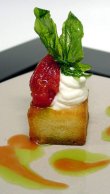|
Native Mint
|
|
Flavor: Very strong savory taste that is closer to peppermint than garden mint in flavor.
Appearance: A fine, free-flowing, dark green powder
Uses: Sauces, pesto, butter, bread, vinegars. Very strong, suggested use rate is around 0.1% (1g/1kg).
|
|
Native Pepperberry (ground)
|
|
Flavor - A bushy spice with a very hot peppery zing.
Appearance: Dark free-flowing powder which bleeds burgundy in sauces especially cream.
Uses: Substitute for pepper but with a distinctive unique flavor. Use sparingly at around 0.1% (1g/kg) or less. Suitable for table use as for black pepper.
|
|
Native pepperberries (Frozen Whole)
|
|
Flavor - A bushy flavor with a hot peppery zing from the seeds.
Appearance: Large peppercorn size. Round and deep purple.
Uses: As a flavor or garnish, add to sauces, butter, bread, pasta, game meats. Bleeds a light burgundy color into cream sauces. Contrasts well with sweet corn kernels. Use approx. 6-8 berries per serve. Storage - Frozen
|
|
Native Peppermint
|
|
Flavor - Peppermint flavor with woody eucalyptus note.
Color and appearance - A free-flowing light green powder.
Typical Uses - Desserts and also as a seasoning for white meat.
Helpful Hints - Very strong, suggested use rate is around 0.1% .
|
|
Native Peppermint Oil
|
|
Flavor: Primary peppermint flavor with woody eucalyptus note.
Color and Appearance - Transparent pale yellow fluid. Typical Uses: Flavor cream, milk, oil, vinegar or stock for desserts, sauces, dressings. Use at 2 to 4 drops per liter of product.
|
|
Native Thyme
|
|
Flavor: Similar to a blend of tarragon, thyme and rosemary.
Appearance: Fine, free-flowing, light green powder.
Uses: Soups, stuffings, herb bread, quiches, omelettes and vegetable seasonings. Suggested use rate is around 0.5% (5g/1kg) as for traditional thyme. Sometimes called native basil.
|
|
Oz Lemon
|
|
Flavor: A unique and intense lemongrass flavor
This unique blend of lemon myrtle, lemon myrtle oils and other natural flavors delivers a more intense lemon myrtle flavor base than lemon myrtle itself.
Uses: This stimulating lemony mix is great as a simple seasoning on fish or poultry or infused into some warm oil and drizzled over any dish which can handle an aromatic, citrusy lift. Add Oz Lemon to desserts, custard, muffins, cheesecakes or pies. Infuse ½ tsp in a ¼ cup of boiling water and brew for 3-5 minutes. Top up with hot water or ice cold mineral water and ice cream.
|
|
Paperbark
|
|
Paperbark is a natural product that is used as a platter liner or when used as a cooking wrap, imparts a delicate smokey flavor from oils in the paperbark. This technique is the easiest way to smoke and cook meats in bark on a hot plate, char-grill or in a pan. Paperbark is low in tannins and while indigestible is harmless if consumed accidentally.
Uses: This product is perfect to wrap fish or chicken in with a light sprinkle of lemon myrtle then put in an oven to bake or put on a dry hot plate. It is also popular as a platter base. If the product is dry, dampen with water to make pliable. (each sheet is approx. 45cm X 30cm in size.)
|
|
Quandong
|
|
Flavor: Mildly tart apricot and peach
Appearance: Bright red fruit
Uses: Sauces (meat or dessert), garnish. Helpful Hints - Do not over-cook. Simmer gently in sauce or apple juice. Enhance with orange juice. Do not over-sweeten. The seed kernels are only safe to eat if well roasted to a milk chocolate brown, which inactivates an unsafe compound.
Storage: Dried
|


